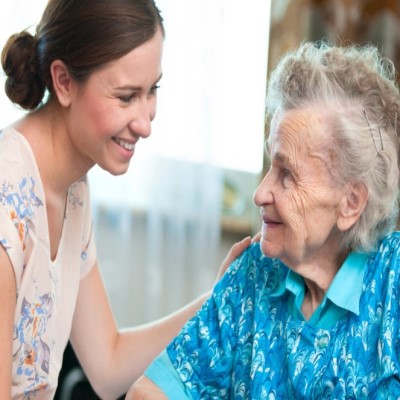Our society increasingly relies on family and friends as caregivers for those who can no longer care for themselves. If you’re doing the hard work of a part- or full-time caregiver, these tips may help you care for your loved one’s skin as part of their overall health.
Skin plays a very practical role as a barrier to germs and diseases and also helps keep our temperature and blood chemistry where it should be. When someone is not able to move and bathe normally, the risk of skin problems increases, including non-healing wounds that can become infected and even dangerous. And even conditions that are generally non-life threatening, such as uncontrolled itching or lower extremity swelling, can make life very difficult.
In addition, the condition of the skin, hair and nails is important to quality of life. Identity and self-image can be significantly affected, and that can contribute to social isolation. Of course, it is important to take into account the individual’s perspective – something that may cause one person to feel disfigured may be seen by someone else as a normal part of aging.
We hope these skincare tips for caregivers help you support your loved one in the best way you can.
Read More: Is Laser Skin Whitening Permanent?
Bathing
Keeping the skin clean is the first step in decreasing the risk of wounds, ulcers, and rashes. However, regular bathing can be difficult, and sometimes frightening, for someone who is in a wheelchair or who has limited mobility. Setting up a safe bathing area, with non-skid surfaces and grab rails, can help significantly. Since hot water contributes to dry skin, a moderate temperature is best.
A gentle soap, such a Dove for Sensitive Skin or Cetaphil Gentle Cleanser, is the best option. Make sure to help rinse well with fresh water. Pat completely dry with towels and avoid rubbing to prevent irritation. It is particularly important to ensure that any folds in the skin (for example, under the breasts) are cleaned and carefully dried. These are common areas for skin infections.
A hair dryer on “cool” setting can also help gently dry the skin to avoid chafing.
Moisturizing
Many elderly people have very dry skin that is more prone to splits or tears. Using a fragrance-free moisturizer like Aveeno Active Naturals Daily Moisturizing Lotion or Cetaphil Cream can help soften the skin and reduce itching. There are tools, such as ReachMate+, that can make it easier for older adults to apply moisturizer themselves. Take care to avoid making the feet slippery when applying moisturizers, and immediately clean any that falls on the floor.
Reducing Prolonged Sitting
Many disabled patients spend hours in a chair or wheelchair since walking is difficult. Sitting for too long in one position can reduce blood flow to the skin of the buttocks. This can lead to a painful red area (“hot spot”) which can eventually lead to an ulcer. Ulcers like this can be very difficult to heal and also lead to infection in the body.
Using a donut-style cushion and repositioning regularly will help. Use a kitchen timer to remind the patient to shift positions frequently – ideally every 15-20 minutes, and every two hours at a minimum. If the person can walk safely, get up and walk regularly. Cushions or mattresses should be soft (like an egg crate). For completely immobile patients, special beds to prevent ulcers are available through your doctor or social worker. See you doctor immediately for any concerns about possible ulcers forming, especially on the bottom or legs.
Incontinence
Some people with serious medical problems have trouble controlling their bowels or bladder. In these cases it is important to keep the person clean and dry and use an adult diaper that is soft and absorbent.
Soft toilet paper with Cetaphil Gentle Cleanser can be used to clean the area (it does not have to be washed off) followed by a protective ointment like Triple Paste or A&D Ointment. For sleeping, disposable pads are available to protect sheets and the bed. Consult your doctor to help look for the cause if someone has new or worsening incontinence.
Swelling and Constrictions
Swelling in the lower legs is a common concern among older adults. Properly fitting compression stockings can help considerably. The Comfort Store here in Austin specializes in fitting these garments, though a doctor’s prescription may be needed for high compression levels.
Avoid anything that constricts the arm or leg, unless using support hose under the care of a doctor. A tight-fitting watch band, socks, or garments can restrict blood flow. Over time, this constriction can cause uncomfortable swelling, damage the skin, and increase the risk for deep vein thrombosis which can be life threatening.
Bruising
Older adults and their caregivers are often concerned by large areas of bruising, particularly on the hands and forearms. Most commonly, this is caused by “senile purpura” which is a benign condition caused by increasing fragility of the skin and blood vessels as the body ages. Though senile purpura is not dangerous, it can be cosmetically troubling. This kind of bruising is very difficult to prevent, since it results from everyday activities. Over-the-counter creams containing arnica (for example, DerMend) may help somewhat. Of course, sudden unexplained bruising should be discussed with a doctor as it could be a sign of trauma or another underlying condition.
Read More: How Can I Tighten the Skin Under My Eyes?
Signs of Skin Cancer
You probably know that older adults are at a significantly increased risk of skin cancer, especially when the patient has a history of previous skin cancers. At the same time, self-monitoring the skin can become more difficult. It is common for older patients to have a large number of lesions on their skin, so noticing a specific spot that is new or changing can be very difficult for a layperson. As a result, it is important to seek the care of a board certified dermatologist when there is a concern about the skin.
When caught early, skin cancer is very treatable even in older patients. When in doubt, have the spot checked out. Even the less dangerous forms of skin cancer can cause significant disfigurement and impairment if left untreated.
Signs of Infection
Even with gentle care, many elderly or disabled people get small cuts, bruises, or ulcers from daily life. Any wound that has redness around it or where the skin is hot, tender, or weeping fluid should be seen immediately by a doctor. If it is at night or on the weekend, go to the nearest emergency room or call 911. Skin infections can worsen rapidly and cause further disability or even death if not treated quickly.
Getting Help
Many social services are available, through insurance and the government, to support disabled patients and their caregivers. Ask your doctor for a referral for services or for a social worker who can help. In Austin, you can also dial 211 to connect to the United Way and over 10,000 healthcare and other services. Being a caregiver for a chronically ill person can be difficult for anyone. Do not be afraid to ask for help for yourself or the person you care for.
Caregiving is very important but also can be very difficult and draining. Don’t try to go it alone but make sure you have support from your family, your doctor, and local social services to help you do the best job you can.

